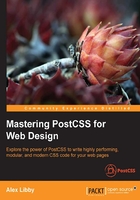
Preface
As a developer, I'll bet you have a perfect workflow—you either write styles using plain vanilla CSS or use one of the current processors, such as SASS or Less, to create them. You'll add vendor prefixes using the likes of Autoprefixer—either manually or using a tool, such as Grunt or Gulp.
Sounds familiar? Why would you want to disturb something if it works for you, right?
Trouble is, a friend or colleague has started talking about a new processor by the name of PostCSS—they've piqued your interest sufficiently to want to find out more about what it is and how it works.
Well, welcome to the fast-growing ecosystem that is PostCSS! By itself, the tool doesn't do anything, but when paired with the right plugins (and there are hundreds available for use), it has the potential to become a really powerful processor for you. Gone are the days when we have to depend on a monolithic library such as SASS or less. Instead, we can pick and choose exactly which plugins to use based on our project requirements. PostCSS is an immensely quick processor to use; the question is, are you ready for the ride?
Here's hoping the answer is yes; if so, let's make a start.